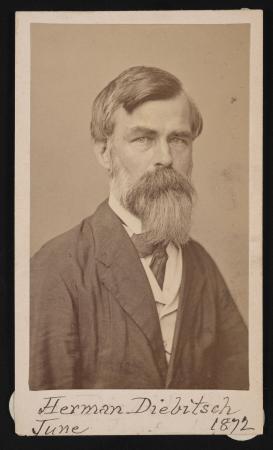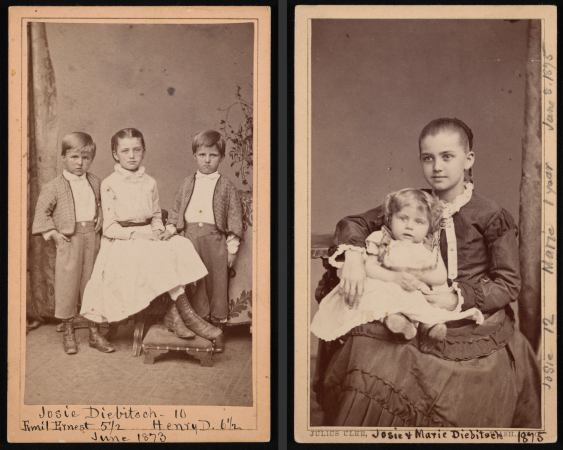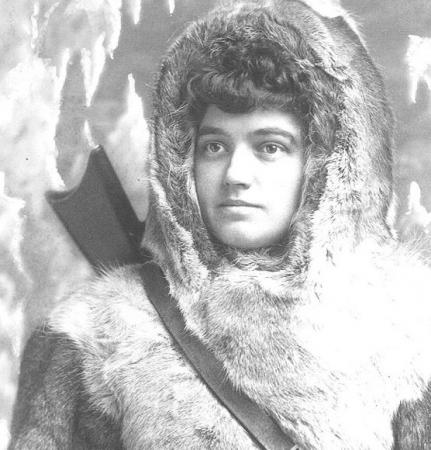We are kicking off a new blog series that will highlight people and their stories, uncovered while conducting research for our recently digitized series of cartes de visite and cabinet cards in Record Unit 95. The Spotlight series will include more in-depth descriptions of these fascinating individuals than are included in our catalog records.
Herman Henry Diebitsch was born in Neustadt, Silesia, Germany in 1818. Following his education he entered the Military Academy in Berlin, and soon after his graduation in 1838 he became a high-ranking officer in the Prussian Army. He left his war-torn country in 1850 and moved to the Washington, D.C. area, and by 1853 he was affiliated with the Smithsonian Institution as a meteorological clerk and observer. During his 30-year relationship with the Smithsonian, he also held roles as a linguist and as clerk in the Exchange Office, later known as the International Exchange Service. In 1861, he married Magdalena Augusta Schmid of Saxony and they lived on a farm in Maryland until it was destroyed during the American Civil War, at which point they relocated to Washington, D.C. Herman and Magdalena had four children, the eldest of whom would gain fame for her role in Arctic exploration.

Josephine Cecilia Diebitsch was born in 1863 on the family farm in Maryland before moving with her parents to Washington, D.C. By all accounts, her family was loving, cultivated her curiosity for the world, and supported her aspirations. She graduated as valedictorian in 1880 from Spencerian Business School, where her progressive values were illustrated in her graduation essay “Work and Training for Women,” a protest against the narrowness of the woman’s sphere and a plea for a higher aim and education for women. With her business education and fluency in several languages she was qualified to follow in her father’s footsteps, and, following his death in 1883, took a position in the Record Division of the Exchange Office at the Smithsonian. Bound for a different destiny, her career trajectory was forever altered when she met naval civil engineer Robert Edwin Peary at a dancing school in 1885.

After a three-year-long distance courtship, Josephine and Robert married in 1888, setting in motion a life of unimaginable adventure. While Peary is well known for his success as an explorer of the Arctic, and in particular for his expedition to the North Pole in 1909, it is little known that his wife joined him on several expeditions to the Arctic and was an invaluable part of their success. Her inclusion in Peary's 1891 expedition to Greenland, an area known for its harsh conditions, was undoubtedly unconventional, and even drew criticism. The Academy of Natural Sciences of Philadelphia, a financial backer of the expedition, was astonished at the decision, going so far as to state: "The addition of a woman to the expedition, therefore, really adds to its perils and difficulties, for however plucky she may be she is not physically able to endure the exhausting labor of a retreat over the ice, which has so often prostrated strong men." Dismissing the condemnation, Josephine went anyway, making her the first non-native woman to travel so far north. She proved herself especially useful when her husband broke his leg, a matter she had to deal with for the six months of recuperation they spent at MacCormick Fjord. Josephine invited further scrutiny when she joined a second expedition to the Arctic in 1893, when she gave birth to their first child, Marie Ahnighito Peary.

While on expeditions, Josephine would hunt, cook, and sew fur clothing for the men. She managed food rationing and bartered trade goods with the Inuit. During one particularly harrowing incident involving an attack by a herd of walruses, Josephine reloaded rifles for the men as fast as they were being discharged. During times when she didn’t join Robert on expeditions, she would use her considerable Washington, D.C., connections to raise funds for his trips. She also published several books and was sought after on the lecture circuit, where people enjoyed her tales of life in the Arctic. Her works include My Tales of the Arctic (1893), The Snow Baby (1901), and Children of the Arctic (1903).
Josephine Diebitsch Peary led an unconventional life, embodying her own vision of what a woman’s life could be, without boundary and outside of societal norms. Though her time at the Smithsonian was short, her pursuits exemplified the spirit of our mission, to strive toward the increase and diffusion of knowledge.
Related Collections:
- Smithsonian Institution, Photograph Collection, Record Unit 95, Smithsonian Institution Archives
Related Resources:
- A YEAR'S WORK ENDED.: Closing Exercises of the Spencerian Business College Last Night. The Washington Post (1877-1922); May 15, 1880; ProQuest Historical Newspapers: The Washington Post pg. 2
- FEARS FOR LIEUT. PEARY.: His Trip to Greenland Based on Misconception ... Chicago Daily Tribune (1872-1922); Sep 3, 1891; ProQuest Historical Newspapers: Chicago Tribune pg. 1
- “Josephine Diebitsch Peary (1863-1955).” Patricia Pierce Erikson. Arctic, vol. 62, no. 1, 2009, pp. 102–104.
- Annual report of the Board of Regents of the Smithsonian Institution, 1883, p. 46.
- Annual report of the Board of Regents of the Smithsonian Institution, 1884, p. 99.
Produced by the Smithsonian Institution Archives. For copyright questions, please see the Terms of Use.

Leave a Comment